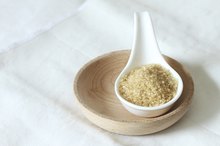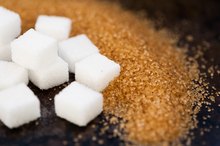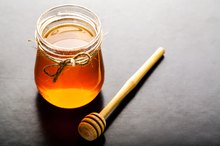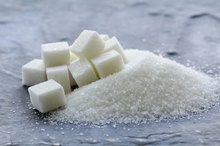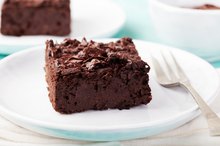How to Substitute Applesauce for Sugar
Learn how to substitute applesauce for sugar in your baking and you’ll have a convenient way to reduce simple sugar content and lend a more complex flavor to your food. Applesauce contains natural sugars that the body breaks down more slowly than refined sugars. These natural sugars don’t increase blood sugar as rapidly and are less likely to irritate sugar-sensitive people. Although applesauce can change the texture of baked goods, it also adds moisture and a subtle spiciness that blends well with most flavors.
Identify the purpose of sugar in the recipe. This will tell you how much of the sugar you can replace. In cold desserts like fruit soup, sugar is just a sweetener. In sweetened side dishes like sweet potato casserole or baked beans, sugar adds both sweetness and flavor. The role of sugar in baking is more complex. Sugar helps aerate and tenderize the food and allows it to brown.
Calories in 1/4 Cup Sugar
Learn More
Check how much sugar the recipe calls for. Use the measurement of volume, such as cups rather than ounces. If the recipe calls for two different types of sugar, such as white sugar and packed brown sugar, use the combined total by volume. Based on the role of sugar in the recipe, decide whether or not you want to reduce the total sugar used. In most baking recipes, you can reduce the sugar by at least a third without affecting the taste or character of the batter.
Measure out the required applesauce. If the food will not be heated, replace the sugar with an equal amount of applesauce. In heated sweet side dishes, as well as cookies, brownies and muffins, you can replace up to two thirds of the sugar. For cakes, however, replace only half the sugar with applesauce. Use about one third more applesauce than the amount of sugar you replaced. For example, in a cake recipe that calls for a cup of sugar, use half a cup of sugar and about 3/4 cup of applesauce.
Fruit Puree as a Sugar Substitute in Baked Goods
Learn More
Reduce liquids in relation to the applesauce. Applesauce contains a considerable amount of moisture. You must rebalance the amounts of liquids and solids to prevent your food from becoming soggy. Reduce the main liquid in the recipe, such as milk, by 1/4 cup for every cup of applesauce you add.
Add the applesauce. In recipes with no heated ingredients, add the applesauce at the point where the recipe calls for sugar. In a baking recipe, beat the applesauce into the eggs. If the recipe calls for butter or oil, mix the fat into the eggs and then add the applesauce.
Tips
If the applesauce isn’t sweet enough for your taste, use vanilla or spices like cinnamon and nutmeg to increase sweetness without adding sugar.
Warnings
Applesauce can’t replace sugar in hard-candy recipes. Even unsweetened applesauce contains sugar. If you’re diabetic, use care when deciding how much applesauce-sweetened food to eat.
Related Articles
References
- Diabetic Lifestyle
- Polyphenolic Compounds Analysis of Old and New Apple Cultivars and Contribution of Polyphenolic Profile to the In Vitro Antioxidant Capacity - PubMed
- Effect of processing on phenolic antioxidants of fruits, vegetables, and grains--a review - PubMed
- Full article: Stability of Apple Polyphenols as a Function of Temperature and pH
- Apple phytochemicals and their health benefits - PubMed
- None
- None
- None
- Cancer chemopreventive potential of apples, apple juice, and apple components - PubMed
- None
- Polyphenolic Compounds Analysis of Old and New Apple Cultivars and Contribution of Polyphenolic Profile to the In Vitro Antioxidant Capacity - PubMed
- Activity and contents of polyphenolic antioxidants in the whole fruit, flesh and peel of three apple cultivars - PubMed
- Which polyphenolic compounds contribute to the total antioxidant activities of apple? - PubMed
- None
- None
- None
- None
- None
- None
- None
- None
- None
- None
- None
- None
- None
- None
- None
- None
- None
- FoodData Central
- Association of Major Food Sources of Fructose-Containing Sugars With Incident Metabolic Syndrome: A Systematic Review and Meta-analysis - PubMed
- Food sources of fructose-containing sugars and glycaemic control: systematic review and meta-analysis of controlled intervention studies - PubMed
- Sugar consumption, metabolic disease and obesity: The state of the controversy - PubMed
- Dietary sugars and body weight: systematic review and meta-analyses of randomised controlled trials and cohort studies - PubMed
- Non-nutritive Sweeteners and Their Associations with Obesity and Type 2 Diabetes - PubMed
- Does low-energy sweetener consumption affect energy intake and body weight? A systematic review, including meta-analyses, of the evidence from human and animal studies - PubMed
- None
- FoodData Central
- Carbohydrate quality and human health: a series of systematic reviews and meta-analyses - PubMed
- The effect of fruit in different forms on energy intake and satiety at a meal - PubMed
- Appendix 3. USDA Food Patterns: Healthy U.S.-Style Eating Pattern - 2015-2020 Dietary Guidelines | health.gov
- Appendix 4. USDA Food Patterns: Healthy Mediterranean-Style Eating Pattern - 2015-2020 Dietary Guidelines | health.gov
- Appendix 5. USDA Food Patterns: Healthy Vegetarian Eating Pattern - 2015-2020 Dietary Guidelines | health.gov
- Hypersensitivity reactions to food and drug additives: problem or myth? - PubMed
- None
- None
- None
- None
- Cinnamon: a multifaceted medicinal plant - PubMed
Writer Bio
Nicole Langton has been a professional writer for over 10 years. She began writing for a natural health company where she developed a deep interest in nutrition and natural treatments. Langton earned a Bachelor of Arts in east central European studies as well as a certificate in English language to teach to adults.
